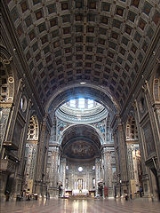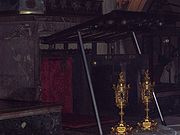
Basilica di Sant'Andrea di Mantova
Encyclopedia
The Basilica concattedrale di Sant'Andrea is a Renaissance
roman catholic church and minor basilica
in Mantua
, Lombardy
(Italy
).
Commissioned by Ludovico II Gonzaga, the church was begun in 1462 according to designs by Leon Battista Alberti on a site occupied by a Benedictine
monastery, of which the bell tower (1414) remains. The building, however, was finished only 328 years later. Though later changes and expansions altered Alberti’s design, the church is still considered to be one of Alberti's most complete works.
 The façade, built abutting a pre-existing bell tower (1414), is based on the scheme of the ancient Arch of Titus
The façade, built abutting a pre-existing bell tower (1414), is based on the scheme of the ancient Arch of Titus
. It is largely a brick structure with hardened stucco used for the surface. It is defined by a large central arch, flanked by Corinthian pilaster
s. There are smaller openings to the right and left of the arch. A novel aspect of the design was the integration of a lower order, comprising the fluted Corinthian columns, with a giant order
, comprising the taller, unfluted pilasters. The whole is surmounted by a pediment and above that a vaulted structure, the purpose of which is not exactly known, but presumably to shade the window opening into the church behind it.
An important aspect of Alberti’s design was the correspondence between the façade and the interior elevations, both elaborations of the triumphal arch motif. The nave of the interior is roofed by a barrel vault
, one of the first times such a form was used in such a monumental scale since antiquity, and quite likely modeled on the Basilica of Maxentius
in Rome. Alberti most likely had planned for the vault to be coffer
ed, much like the smaller barrel vault in the entrance, but lack of funds led to the vault being constructed as a simple barrel vault with the coffers then being painted on. Originally, the building was planned without a transept
, and possibly even without a dome
. This phase of construction more or less ended in 1494.
In 1597, the lateral arms were added and the crypt finished. The massive dome (1732-1782) was designed by Filippo Juvarra
, and the final decorations on the interior added under Paolo Pozzo and others in the late 18th and early 19th centuries.
 The purpose of the new building was to contain the pilgrims who visited it during the feast of Ascension when a vial, that the faithful argue contains the Blood of Christ
The purpose of the new building was to contain the pilgrims who visited it during the feast of Ascension when a vial, that the faithful argue contains the Blood of Christ
, is brought up from the crypt below through a hole in the floor directly under the dome. The relic
, called Preziosissimo Sangue di Cristo ("Most Precious Blood of Christ
"), is preserved in the Sacred Vessels, according to the tradition was brought to Mantua by the Roman centurion Longinus. It was highly venerated during the Renaissance. This shrines are displayed only on the Good Friday
, to the faithful and then brought out along the streets of Mantua in a procession.
, with a bronze figure of him, by Gianmarco Cavalli. Other artworks in the chapels include frescoes of Giulio Romano
's school (a work by Giulio is currently a copy) and by Correggio
.
Renaissance
The Renaissance was a cultural movement that spanned roughly the 14th to the 17th century, beginning in Italy in the Late Middle Ages and later spreading to the rest of Europe. The term is also used more loosely to refer to the historical era, but since the changes of the Renaissance were not...
roman catholic church and minor basilica
Minor basilica
Minor basilica is a title given to some Roman Catholic churches. By canon law no Catholic church can be honoured with the title of basilica unless by apostolic grant or from immemorial custom....
in Mantua
Mantua
Mantua is a city and comune in Lombardy, Italy and capital of the province of the same name. Mantua's historic power and influence under the Gonzaga family, made it one of the main artistic, cultural and notably musical hubs of Northern Italy and the country as a whole...
, Lombardy
Lombardy
Lombardy is one of the 20 regions of Italy. The capital is Milan. One-sixth of Italy's population lives in Lombardy and about one fifth of Italy's GDP is produced in this region, making it the most populous and richest region in the country and one of the richest in the whole of Europe...
(Italy
Italy
Italy , officially the Italian Republic languages]] under the European Charter for Regional or Minority Languages. In each of these, Italy's official name is as follows:;;;;;;;;), is a unitary parliamentary republic in South-Central Europe. To the north it borders France, Switzerland, Austria and...
).
Commissioned by Ludovico II Gonzaga, the church was begun in 1462 according to designs by Leon Battista Alberti on a site occupied by a Benedictine
Benedictine
Benedictine refers to the spirituality and consecrated life in accordance with the Rule of St Benedict, written by Benedict of Nursia in the sixth century for the cenobitic communities he founded in central Italy. The most notable of these is Monte Cassino, the first monastery founded by Benedict...
monastery, of which the bell tower (1414) remains. The building, however, was finished only 328 years later. Though later changes and expansions altered Alberti’s design, the church is still considered to be one of Alberti's most complete works.
History

Arch of Titus
The Arch of Titus is a 1st-century honorific arch located on the Via Sacra, Rome, just to the south-east of the Roman Forum. It was constructed in c.82 AD by the Roman Emperor Domitian shortly after the death of his older brother Titus to commemorate Titus' victories, including the Siege of...
. It is largely a brick structure with hardened stucco used for the surface. It is defined by a large central arch, flanked by Corinthian pilaster
Pilaster
A pilaster is a slightly-projecting column built into or applied to the face of a wall. Most commonly flattened or rectangular in form, pilasters can also take a half-round form or the shape of any type of column, including tortile....
s. There are smaller openings to the right and left of the arch. A novel aspect of the design was the integration of a lower order, comprising the fluted Corinthian columns, with a giant order
Giant order
In Classical architecture, a giant order is an order whose columns or pilasters span two stories...
, comprising the taller, unfluted pilasters. The whole is surmounted by a pediment and above that a vaulted structure, the purpose of which is not exactly known, but presumably to shade the window opening into the church behind it.
An important aspect of Alberti’s design was the correspondence between the façade and the interior elevations, both elaborations of the triumphal arch motif. The nave of the interior is roofed by a barrel vault
Barrel vault
A barrel vault, also known as a tunnel vault or a wagon vault, is an architectural element formed by the extrusion of a single curve along a given distance. The curves are typically circular in shape, lending a semi-cylindrical appearance to the total design...
, one of the first times such a form was used in such a monumental scale since antiquity, and quite likely modeled on the Basilica of Maxentius
Basilica of Maxentius
The Basilica of Maxentius and Constantine is an ancient building in the Roman Forum, Rome, Italy...
in Rome. Alberti most likely had planned for the vault to be coffer
Coffer
A coffer in architecture, is a sunken panel in the shape of a square, rectangle, or octagon in a ceiling, soffit or vault...
ed, much like the smaller barrel vault in the entrance, but lack of funds led to the vault being constructed as a simple barrel vault with the coffers then being painted on. Originally, the building was planned without a transept
Transept
For the periodical go to The Transept.A transept is a transverse section, of any building, which lies across the main body of the building. In Christian churches, a transept is an area set crosswise to the nave in a cruciform building in Romanesque and Gothic Christian church architecture...
, and possibly even without a dome
Dome
A dome is a structural element of architecture that resembles the hollow upper half of a sphere. Dome structures made of various materials have a long architectural lineage extending into prehistory....
. This phase of construction more or less ended in 1494.
In 1597, the lateral arms were added and the crypt finished. The massive dome (1732-1782) was designed by Filippo Juvarra
Filippo Juvarra
Filippo Juvarra was an Italian architect and stage set designer.-Biography:Filippo Juvarra was an Italian Baroque architect working in the early part of the eighteenth century. He was born in Messina, Sicily, to a family of goldsmiths and engravers...
, and the final decorations on the interior added under Paolo Pozzo and others in the late 18th and early 19th centuries.
Relic of the Holy Blood

Blood of Christ
The Blood of Christ in Christian theology refers to the physical blood actually shed by Jesus Christ on the Cross, and the salvation which Christianity teaches was accomplished thereby; and the sacramental blood present in the Eucharist, which is considered by Catholic, Orthodox, Anglican, and...
, is brought up from the crypt below through a hole in the floor directly under the dome. The relic
Relic
In religion, a relic is a part of the body of a saint or a venerated person, or else another type of ancient religious object, carefully preserved for purposes of veneration or as a tangible memorial...
, called Preziosissimo Sangue di Cristo ("Most Precious Blood of Christ
Christ
Christ is the English term for the Greek meaning "the anointed one". It is a translation of the Hebrew , usually transliterated into English as Messiah or Mashiach...
"), is preserved in the Sacred Vessels, according to the tradition was brought to Mantua by the Roman centurion Longinus. It was highly venerated during the Renaissance. This shrines are displayed only on the Good Friday
Good Friday
Good Friday , is a religious holiday observed primarily by Christians commemorating the crucifixion of Jesus Christ and his death at Calvary. The holiday is observed during Holy Week as part of the Paschal Triduum on the Friday preceding Easter Sunday, and may coincide with the Jewish observance of...
, to the faithful and then brought out along the streets of Mantua in a procession.
Other aspects
One of the chapels houses the tomb of painter Andrea MantegnaAndrea Mantegna
Andrea Mantegna was an Italian painter, a student of Roman archeology, and son in law of Jacopo Bellini. Like other artists of the time, Mantegna experimented with perspective, e.g., by lowering the horizon in order to create a sense of greater monumentality...
, with a bronze figure of him, by Gianmarco Cavalli. Other artworks in the chapels include frescoes of Giulio Romano
Giulio Romano
Giulio Romano was an Italian painter and architect. A pupil of Raphael, his stylistic deviations from high Renaissance classicism help define the 16th-century style known as Mannerism...
's school (a work by Giulio is currently a copy) and by Correggio
Antonio da Correggio
Antonio Allegri da Correggio , usually known as Correggio, was the foremost painter of the Parma school of the Italian Renaissance, who was responsible for some of the most vigorous and sensuous works of the 16th century...
.
External links
- Mantua tourist guide Mantua tourist guide
- Basilica Concattedrale di S. Andrea - complesso

